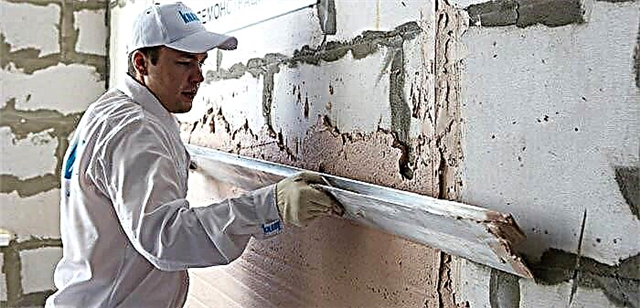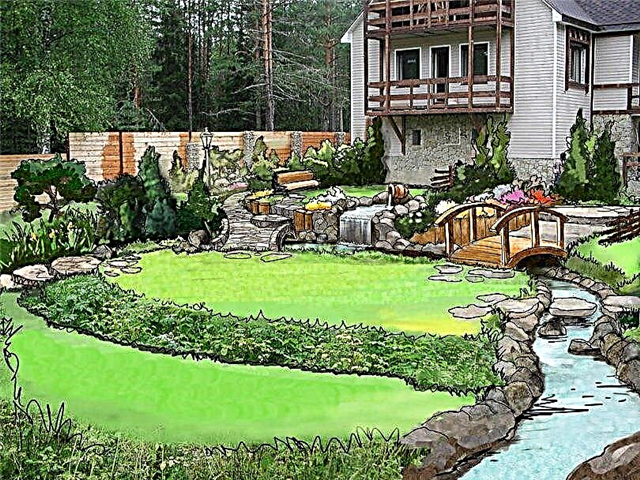Our company cares about the health of its customers. Attention! From 03/28 - Our showroom will be closed for visits, but we accept orders from 11.00 to 18.00 by phone: +7 495 255-34-88, by e-mail: [email protected] and in online chat! All shipment of orders will be made on schedule, through the courier service or pickup after the opening of the show room.
We also work in online mode (we can come to you with samples, more details from our phone managers). In connection with the current situation, we have a 15% discount on all goods and services, free delivery in Moscow for orders of 10,000 rubles and more.!
The atmosphere of the room depends on the interior, decoration. The component of the decor is the curtains, the choice of which must be approached with responsibility. The KlasTek store offers cloths for tailoring of curtains of various colors, density.
Creating comfort is possible with the right selection of material. To order curtain fabrics in Moscow, call: +7 (495) 255-34-88, or come to the store.
Types and description of materials
The following types of curtain fabrics:
- Atlas is a noble silk or semi-silk woven fabric with a perfectly smooth and even front surface. In the interior, curtains made of such fabric look elegant and elegant.
- Voile - a thin cotton canvas, plain or printed. Hypoallergenic and non-toxic material that is suitable for decorating a children's room.
- Silk - used for decorating luxurious interiors. Natural silk looks rich, shiny, shimmers and drapes well, but gradually collapses under the influence of direct sunlight. Artificial silk can be used as an alternative.
- Flax is a natural eco-friendly material, breathable, with a pronounced antibacterial effect. Such a curtain is used in interior design in an eco-style and for children's rooms, where it is important to ensure a good microclimate.
- Taffeta is a thin, smooth woven fabric with shiny tints. Made from cotton, silk, acetate or polyester. With a certain combination of multi-colored warp and weft threads, you can achieve the effect of "chameleon" when the fabric shimmers at any angle.
- Satin is a natural cotton material that looks like a silk canvas. It is never out of fashion and is suitable for interior decoration in any style.
- Jacquard is a universal curtain fabric that can be used to decorate large halls, bedrooms or living rooms. In its manufacture, weaving of natural and synthetic yarns is used, due to which high strength and wear resistance of the finished curtain are achieved.
- Chenill is a jacquard fabric with a pleasant velvety texture. In its manufacture, several multi-colored threads can be simultaneously intertwined. Suitable not only for sewing curtains, but also for furniture upholstery.
- Velvet is a canvas with a dense short pile. This is a luxurious material for curtains, which is a sign of aristocracy and wealth. Suitable for large halls, living rooms and bedrooms.
How to choose fabrics for curtains to the interior
General recommendations for choosing material for curtains:
- Dense curtain fabric for curtains is suitable for living rooms and halls with large windows where there is an excess of sunlight. Jacquard and velvet curtains will look perfect in such a room.
- For rooms where there is expensive furniture, the upholstery of which can be damaged by sunlight, the density of the curtain fabric should be maximum. In such an interior, it is advisable to use blackout material.
- The width of the curtain fabric should be 2-2.5 times greater than the width of the cornice. This is the only way to get the necessary plasticity of the curtains and beautiful overflows on the folds.
Fabric for curtains: a variety of materials, for which curtains which fabrics are better
When choosing a material for curtains, the following characteristics are taken into account:
- Composition (natural, synthetic, mixed),
- The density of the canvas, the tendency to drapery,
- Wear resistance (to ultraviolet, mechanical impact, cleaning agents).
The range of fabrics offered is striking in variety.
Modern technology makes fabrics practical. Thanks to special impregnations, they become waterproof, tough (able to keep their shape), indestructible, not fading in direct sunlight.
The variety of available materials for curtains is replenished with the development of the latest technologies.
In addition, the treatment makes the material resistant to odors, and non-combustible.
The leaders in popularity are velvet, chenille, jacquard, taffeta, veil and organza. Natural fabrics are also in demand: linen, cotton, wool and silk.
For the classic style, luxurious fabrics for curtains (velvet or jacquard) are used. Dense and heavy curtains are beautifully draped and elegantly look even in complex designs with lambrequins and swags.
Drapes almost always complement the thin tulle covering the window in the daytime.
Modern style prefers natural or high-quality synthetic fabrics. Since practicality is appreciated in this area of interior design, modern know-how is also actively used. For example, blackout fabrics that can reliably protect from sunlight, excess sounds, as well as warm in the winter and add coolness in the hot summer.
Lightproof fabric made from polyester fiber with single or double satin weave.
Drapery fabrics: description, name and photo of fabrics for curtains, selection recommendations
Undoubtedly, natural curtain fabric is the best choice.
If you want curtains to serve you for a long time, choose fabrics treated with protective compounds.
Linen is perfect for modern style, as well as for window decoration in an exquisite classic. Benefits:
- Wear resistance,
- UV Resistance
- Easy to wash
- Strength.
Flax has a rough texture and a peculiar structure, has increased mechanical strength.
- High price,
- Crease,
- Shrinkage after washing
- Requires the use of special detergents.
In the photo linen curtains in a modern interior.
Flax does not accumulate static electricity on its surface, does not form a pile.
Gunny is a coarser texture. A characteristic difference is a checkerboard weaving of threads. The fabric is made of natural fibers with the addition of synthetic materials. The surface may be fleecy or smooth. Advantages of matting:
- Wear resistance,
- Resistant to deformation
- It does not require special care,
- Spectacular appearance: even a simple model looks nontrivial.
It is easy to recognize the gunny on the basis of a rough texture, similar to burlap and a checkerboard weave pattern.
- The edges are crumbling
- Puffs remain on the canvas, not recommended for apartments with pets.
Gunny without ornament. Volumetric drapery and rich color create a cozy atmosphere.
Curtains from this fabric look very original, despite the plain appearance.
Gabardine. It is made of natural fibers: wool, cotton or silk. A dense texture is achieved due to the diagonal weaving of the threads.
- Wear resistance,
- Breathability
- Does not deform when washing,
- Easy care
- Moisture resistant.
The main feature is the diagonal weave, which gives density and relief.
- Tendency to fall,
- Sewing may damage the needle.
Drapes from monophonic gabardine of pleasant brown color. The model complements a light tulle of the same shade.
Gabardine is a fabric with a natural composition.
Luxurious velvet is a complement to the classic interior. Pleasant soft texture and the ability to drape beautifully allow you to create curtain masterpieces. Velvet is able to protect not only from excess light, but also provide noise insulation. Despite the saturated colors, it is not prone to fading and can be applied to windows on the sunny side.
Well suited for curtains with drapery, perfectly protects the room from sunlight, noise.
Having decided to opt for this material, it is an honor to:
- The curtain rail for the curtains must be strong, because the velvet is heavy,
- Velvet is appropriate only in large rooms, and in small rooms it will visually reduce the size of the room.
The interior with bright velvet curtains is complemented by decorative pillows made of the same fabric.
It is good to use it in classic interiors to form a solemn appearance of the room.
The complex interweaving of threads in the jacquard fabric allows you to create amazing patterns and ornaments. Due to the texture and color of the material, the curtains are especially beautiful and stylish.
Jacquard - a material with a two-layer pattern due to the interweaving of threads.
Jacquard fabrics do not fade in the sun, do not require special care, and a huge range of colors allows you to choose the option for any style.
Jacquard is a beautiful, strong and very durable coarse fabric.
Uncomplicated jacquard curtains adorn the living room. Even without the addition of tulle, they look organic.
Design Tips
It is not enough to hang curtains from curtains on the windows, you still need to learn how to combine them correctly with other elements in the interior. Designers advise:
- In the bedroom, curtains and bedspreads choose from the same curtain fabric. According to the same principle, the curtains on the windows in the kitchen are combined with a tablecloth, and in the living room with furniture upholstery.
- If the wallpaper in the room has a bright pattern, then the curtains are best to choose plain, and vice versa.
- Blackout curtains with good drapery, which visually stretch the room, will fit in a room with low ceilings.
Properly selected curtains perform both practical and decorative functions. They harmoniously fit into any interior and favorably emphasize the given style in the design of the room.
Fabrics for curtains: description, name and image of fabric, specifics choice for curtains
The range of fabrics for curtains is huge. Here are just a few of the options.
Organza - a crushproof fabric, wearproof, translucent. Not only curtains are made from it, but also canopies and canopies in bedrooms, and other decorative elements of the interior.
The use of organza curtains creates a cosiness and a fabulous atmosphere of the East in the room.
Keeps its shape and allows you to create sophisticated sophisticated designs.
Mesh - a cloth made by hand or using special knitting machines. As a rule, natural threads are used for its manufacture: cotton, linen or wool. There are synthetic analogues from viscose or acetate.
The shape of the mesh cells is diverse. But any, even the most concise model looks spectacular.
One of the most expensive options for curtains is guipure. A significant difference from others in the sophistication of color and texture. As a rule, guipure is painted in pastel colors, which, in combination with airy patterns, create a light weightless haze around the window. It is better if such curtains are used independently, without curtains. Then it becomes possible to appreciate the sophistication of the canvas.
Guipure is made both manually and on special equipment.
Guipure needs special care. Erase it only by hand. Do not wring out so as not to damage the canvas.
Types of light fabrics for curtains: translucent and transparent fabrics, name and description of materials
The most popular among translucent fabrics for curtains is a veil. It is soft and dull. You can create different designs from it, because, despite its lightness and airiness, it holds its shape perfectly.
Today, the most common synthetic veil. And before this material was made exclusively from natural fibers.
Veil is a translucent smooth and thin material, with a matte surface.
The disadvantages of the veil include the difficulty of removing grease stains, as well as its ability to attract dust. Finally, if direct sunlight enters the canvas, the fabric loses its original color.
A light translucent veil with drapery can very well be used without curtains. And a variety of shades allows you to create real masterpieces for window decoration.
Another option for translucent curtains is Kisei. The advantage of such curtains is universality.
Filament curtains are used to decorate window and doorways, and for zoning the space, and as a spectacular decorative element of the interior.
It is such curtains in the interior that give a feeling of complete freedom and transparency of the surrounding space.
Cheap grades of fabric for curtains
Synthetic or mixed materials are the most affordable options. Polyester, acrylic and nylon - soft, with ease, perfectly draped. Harmoniously complement any style. A variety of colors will allow you to choose the fabric for the interior.
Luxurious model of curtains made of polyester. Straight canvases with contrasting pickups. Great color combination.
Polyester does not crease, holds its shape and does not sit after exposure to temperature.
Japanese polyester panels. A competent choice of color guarantees a stylish interior design.
Choose the length of the curtains in accordance with the idea.
An unusual solution: pleated curtains made of orange polyester.
Material properties make it possible to create stable folds on a polyester product, if necessary.
It is worth noting that each of the models is simple in execution, and if you wish, you can create such curtains at home. This will save on window design without sacrificing elegance and beauty.
In order for your curtains to serve you as long as possible, you must follow the rules for caring for them.
The choice of fabrics for curtains is huge. Drapery or curtain fabric does not have to be expensive. Fantasy and a non-standard approach to the design of the room will make the interior truly unique.
The choice of curtains depending on the purpose of the room
By variety, the curtains are divided into horizontal and vertical. By appointment, they are divided into curtains and curtains. The first are sewn from dense heavy fabrics (satin, velvet, polyester, taffeta). The second ones are sewn of their light air materials to diffuse light and partially protect the room from the outside world. Use fabrics such as veils, organza, kisei.
 Pelmet
Pelmet
Kitchen
The kitchen is rich in all kinds of smells of cooked foods, evaporated moisture. Fabrics used in the kitchen should be easy to clean, resistant to fading and transmit light. Use cotton fabric natural fabrics and with synthetic additives, organza. The kitchen can be decorated with three-color checkered curtains or with a bright print.
 Kitchen Cotton Curtains
Kitchen Cotton Curtains
Living room
The guest room should have a certain interior, decorated with velvet, brocade, silk, satin, jacquard. These fabrics are chosen for the living room. This room characterizes the wealth and respectability of the owner. Types of fabrics for curtains is diverse.
 Living room
Living room
Bedroom
The sleeping room should be protected from daylight. Maximum rest and recovery take place in a room well isolated from sounds.To design window openings, polyester, taffeta, viscose and linen fabrics are used. Bright and colorful colors are not welcome.
 Bedroom
Bedroom
Children
The room for the baby should transmit light when it is awake and obscured during sleep. Use easy-care tissue. Cotton and linen curtains can be replaced with blended fabrics based on silk or taffeta. A prerequisite is the provision of environmental materials that do not cause allergies.
The choice of colors is individual. Some children manage to fall asleep looking at bright pictures and patterns, while others prefer a darkened room without external irritants. The fabric for curtains may be different.
 Children's room
Children's room
What should be the curtain fabric
Qualitative characteristics of matter determine the style of the future interior. The artistic decision of the whole room depends on the right curtains. Cost does not always justify the quality and appearance of matter.
The following fabric characteristics are in demand:
- wear resistance
- light permeability
- sound absorption
- persistent coloring
- crush resistance,
- form rigidity,
- certain weight of the canvas
- the possibility of drapery,
- UV resistance
- ease of care
- affordable price.
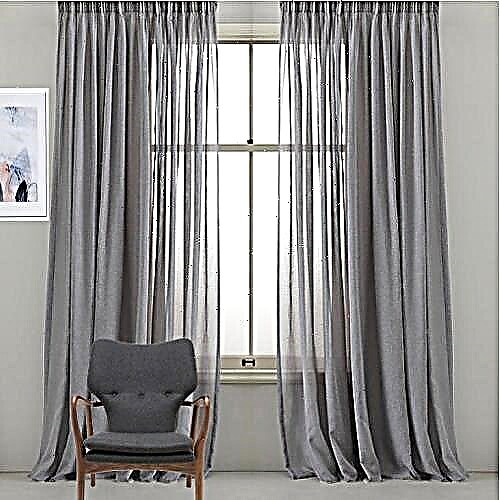 Color combination curtains and curtains
Color combination curtains and curtainsWhat fabric for curtains is better to choose
Depending on where the curtain will hang, the material is selected according to the main criteria that correspond to the needs of the buyer.
- By coloring, you can determine the purpose of the future canvas. Bright plain colors or in the style of a jacquard pattern can be used in the living room. Be sure to withstand the combination of color curtains with the solidity of furniture.
- According to the structure of weaving fibers. Curtains made of gunny or burlap are not suitable for expensive Italian furniture. The unified style of the interior is controlled by design taste.
- Multilayer curtains on a high and narrow window will not look if the structure is narrowed in space. To expand the room using light colors.
- The density of the fabric and the presence of the pattern does not allow the creation of multilayer curtains. And the fragility of the lambrequin design can upset any housewife after the first wash.
Note! In the design of the interior, many factors must be taken into account. Classic style will help out anyway.
Fabric gunny for curtains
Drapery fabric resembling burlap adds zest to the interior, making it cozy. The dense cloth protects well from ultraviolet radiation. Environmentally friendly material made of cotton, linen or with the addition of silk, acrylic or polyester. The composition of matter can change, the pattern remains unchanged. The interweaving of paired threads creates a semblance of a “checkerboard”. Suitable for the kitchen and living room, combined with wooden unvarnished furniture in bright colors.
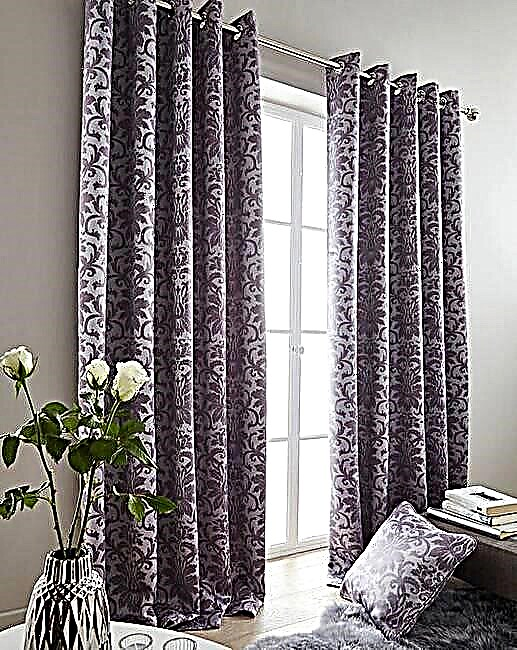 Jacquard Drapes
Jacquard Drapes
Durable canvas made from natural ingredients. It holds sharp folds used in blinds and folded curtains. The rigid base does not allow drapery of the canvas, so linen curtains are used in a flat form in the same plane.
Velvet
Fabric for curtains with a pile based on cotton, silk or viscose fibers. They add luxury to the interior, protect the room well from light and create an atmosphere of mystery and glamor. Velvet drapery is heavy, but it retains heat perfectly and gives the room a solemn style. The material is expensive, not wear-resistant, loses color during washing and quickly parted with a pile.
 Matting Curtains
Matting Curtains
Nylon
Elastic material of artificial origin will soon celebrate its 100th anniversary. Qualitative characteristics are close to silk. Strong and easy material is easily painted. The elasticity of the curtain fabric depends on the density, which varies with the purpose of the canvas. It is widely used in the manufacture of various types of clothing. Easy care of nylon products, almost no ironing. Wash in water at room temperature. It is easily washed off from various pollution.
 Opaque nylon
Opaque nylon
Atlas
The fabric with a shiny front surface is characterized by high strength and wear resistance. Attractive appearance is ensured by fibers of silk, linen and cotton. Easy to stain. Drapable. Has some features in the care. Satin fabric has always been highly regarded. Gives the interior a special sophistication.
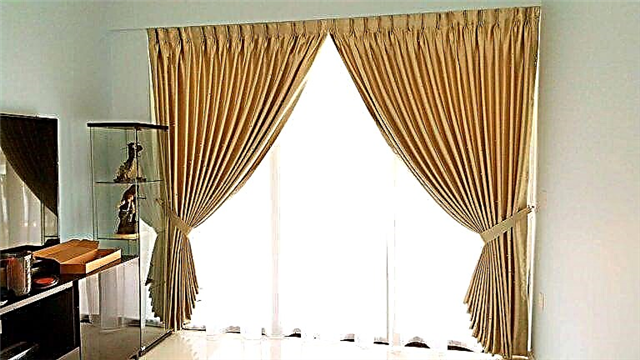 Satin curtains
Satin curtains
Wool
Woolen fabrics for curtains are used in a thin design, without lint. They retain heat and light very well. Easy to drape. The color scheme corresponds to mylar fabrics for clothes. There are no bright and patterned canvases. Do not tolerate washing at hot water temperatures, attract pests in the form of moths. They need periodic ventilation. May absorb unpleasant odors. When synthetic fiber is added, the fabric acquires more advantages than disadvantages.

